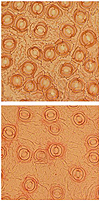A study of plant samples from the past 150 years shows that as atmospheric concentrations of carbon dioxide have steadily increased, the density and size of pores that allow plants to breathe has decreased, also reducing the plants’ transpiration of water. The undersides of leaves contain pores, or stomata, that enable plants to absorb CO2 and release water into the air. When researchers at Indiana University and Utrecht University in the Netherlands examined leaves from Florida herbarium collections dating back 150 years, and compared them with leaves from the same plant species today, they found that the density of stomata has decreased 34 percent, presumably because greater atmospheric concentrations of CO2 have enabled the plants to absorb sufficient CO2 with fewer pores. That decrease in stomata has led to a “huge reduction in the release of water into the atmosphere,” said one of the researchers. These change have occurred as atmospheric concentrations of CO2 have risen from about 290 parts per million to 390 million today. Should CO2 concentrations double in the future, the researchers — reporting in the journal Proceedings of the National Academy of Sciences — said that the amount of water released by plants could be cut by half, which would have a profound impact on the global hydrological cycle.
As CO2 Levels Have Risen, Plants Are Releasing Less Water, Study Says
More From E360
-
Oceans
Dire Straits: Can a Fishing Ban Save the Elusive European Eel?
-
Climate
Scientists Are Trying to Coax the Ocean to Absorb More CO2
-
INTERVIEW
Marina Silva on Brazil’s Fight to Turn the Tide on Deforestation
-
Solutions
Solomon Islands Tribes Sell Carbon Credits, Not Their Trees
-
INTERVIEW
With Sea Turtles in Peril, a Call for New Strategies to Save Them
-
RIVERS
Jared Kushner Has Big Plans for Delta of Europe’s Last Wild River
-
Energy
A Nuclear Power Revival Is Sparking a Surge in Uranium Mining
-
OPINION
Despite Official Vote, the Evidence of the Anthropocene Is Clear
-
INTERVIEW
At 11,500 Feet, a ‘Climate Fast’ to Save the Melting Himalaya
-
Oceans
Octopuses Are Highly Intelligent. Should They Be Farmed for Food?
-
Climate
Nations Are Undercounting Emissions, Putting UN Goals at Risk
-
Solutions
As Carbon Air Capture Ramps Up, Major Hurdles Remain
